
The North Shore War Diary on the morning of July 5 records that the men were “sleepy and hungry” and although the “shelling from enemy mortars was heavy there was no let-down in Spirit.” That shelling went on all through the day, diminishing somewhat after noon. By then, the Germans had decided that, since they could not retake Carpiquet, they would keep it under harassing fire while they reorganized their defences and prepared to abandon positions north and west of Caen. And so for the next four days, the NSR and the rest of the 8th Brigade hung on in Carpiquet and endured the constant, if somewhat lighter, shelling. The men lived a troglodyte existence, moving from trench to trench, keeping out of sight, constantly digging their friends out of collapsed buildings and defences, and enduring the steady drain on strength caused by the constant shell fire. Sergeant Rod Foran captured some of the spirit of the North Shore in the aftermath of the battle in his poem, “The Day A Robin Sang at Carpiquet,” reproduced in the appendix.
Around suppertime on July 5, five officers and 120 men arrived in the shell-torn village as much needed reinforcements for the NSR. “So many reinforcements had come in that I did not know half my men,” Lieutenant Paul McCann recalled. “Often there would be a dozen arrive at a company in the evening and before morning half that dozen would be casualties.” For all the new men, Carpiquet was a brutal indoctrination. Padre Hickey later lamented that many of the men he met for the first time in the evening he buried the next morning.
North Shore graves, Beny-sur-Mer Commonwealth War Cemetery: Private A.G. Maclean, July 6, 1944; Private E.L. Thomas, July 4, 1944; Private J.W. Poirier, July 4, 1944; Private W.T. Lockhart, July 4, 1944; Private B. LeBlanc, July 5, 1944. Matt Symes
Relief only came with the main Anglo-Canadian assault on Caen, which began on the evening of July 7, with a thousand Lancaster bombers pounding the northern outskirts of the city. This was, according to the War Diary, a “great morale builder” for the troops. The next day, forward observers from the artillery operating in Carpiquet were able to engage good targets as German forces on the plain to the north moved in response to the Canadian attack sweeping down from Buron and Cairon. This ability to look into the rear of the German defences was what made Carpiquet so vital. Although Caen north of the Orne river fell on the eighth, Carpiquet was still under fire on July 9 when Lieutenant-Colonel Buell was ordered to moved his battalion forward to occupy the village of Bretteville-sur-Odon in the valley to the southeast. The advance began in mid-afternoon, and with that the NSR left Carpiquet for good.
The memory of those seven days, and the legacy of 289 men lost — seventy-seven of them dead — would remain forever. In regimental lore, the old North Shore had died at Carpiquet. When the 189 casualties from June are added to the Carpiquet losses, the figure from June 6 to July 9 comes to 478 killed, wounded, and missing, the equivalent of the rifle strength of the battalion. The replacements came from the general army pool and included officers, NCOs and men from across Canada. It is true that the NSR would never again be that tight band of rugged northern New Brunswickers. But the battalion had made the best of an impossible task on D-Day and at Carpiquet won an unheralded victory against the odds, with its spirit and cadre intact, an achievement that some in the army noticed. In any event, the campaign in northwest Europe was just getting started: there was still work to be done.